Why SNAPPER?
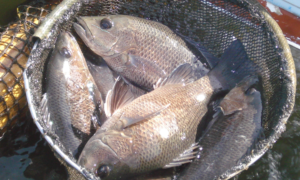 Mangrove red snapper (locally known as maya-maya, mangagat, managat, and gingaw) is a high-value marine fish with great potential for export to Japan, Singapore, Hong Kong, China, Taiwan, and the USA. It is a fast-growing fish that can be reared easily in captivity and can survive well in all phases of culture, from hatchery to grow-out.
Mangrove red snapper (locally known as maya-maya, mangagat, managat, and gingaw) is a high-value marine fish with great potential for export to Japan, Singapore, Hong Kong, China, Taiwan, and the USA. It is a fast-growing fish that can be reared easily in captivity and can survive well in all phases of culture, from hatchery to grow-out.
How to culture SNAPPER?
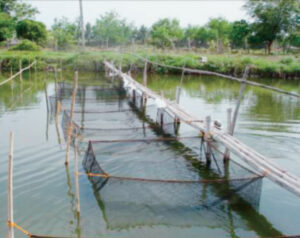
Nursery in netcages
- Stock 2.5 cm fingerlings at a density of 150-200 fingerlings/m3.
- Provide black net ribbons over the cage and set PVC cuttings one over the other at the bottom of the cage as a shelter for the fish.
- Cover each cage with old or used nets, coconut fronds, or nipa shingles to protect the stock from direct sunlight and predator birds.
-
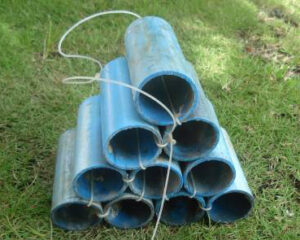
PVC cuttings as fish shelter Feed fish with formulated diets at 12 % of average body weight (ABW) per day, gradually decreasing to 4 % of ABW. Spread out feeding to 4-5 times per day to make feed always available to fish and reduce cannibalism.
- Harvest snapper juveniles when they reach the weight of 40-50 g.
Grow-out in ponds
-
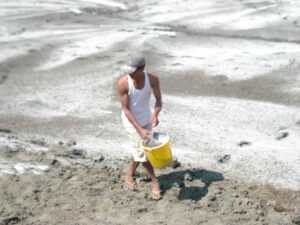
Application of lime in a pond Drain and level the pond, making the pond bottom slope gradually towards the gate. Soil-seal the pond gate by filling mud between rows of slabs. Repair and install gate screens and slabs. Eradicate unwanted species using a mixture of hydrated lime plus ammonium sulfate at a 5:1 ratio, and apply on days with intense sunlight. Dry the pond for about 2-3 weeks until the soil cracks. Apply hydrated lime at 0.5-1 ton/ha. Install bamboo catwalks. Let brackish water flow into the pond during high tide.
-
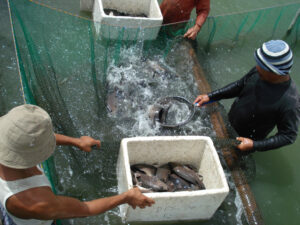
Harvest of snapper Stock 5,000 pieces of snapper juveniles in a one-hectare pond.
- Change 50-60 % of the pond water 4-6 times every high tide. During low tide, it may be necessary to pump water to maintain a water depth of 1 m.
- Give daily feed ration at 8 a.m., 12 noon, and 4 p.m. with 30 %, 30 %, and 40 % allocation, respectively.
- Harvest snapper after six months or when the fish attain the preferred marketable size of ≥400 g.
Is SNAPPER nursery production profitable?
Technical assumption for a cage-nursery production using formulated diets
| Project duration (years) | 5 |
| Total pond area for stocking (m2) | 4,000 |
| Number of cages (2 x 3 x 1.3 m3) | 8 |
| Number of crops/year | 3 |
| Stocking density (pcs/m3) | 150 |
| Total number of stock per crop | 7,200 |
| Days of culture | 90 |
| Feed conversion ratio | 1.8 |
| Survival rate | 90 % |
| Total recovery at harvest per crop (pcs) | 6,480 |
| ABL at harvest (cm) | 10 |
| Selling price per cm body length (PhP) | 2 |
| Farm gate selling price (PhP/pc) | 20 |
| Gross value of harvest per crop (PhP) | 129,600 |
Costs-and-returns (as of 2018)
| Total variable cost per year (PhP) | 195,126 |
| Total fixed cost per year (PhP) | 91,092 |
| Net income per year (PhP) | 102,582 |
| Internal rate of return (%) | 317 |
| Return-on-investment (%) | 281 |
| Payback period (years) | 0.31 |
Is SNAPPER farming profitable?
Technical information of snapper grow-out culture in ponds using formulated diet
| Project duration (years) | 5 |
| Area (ha) | 0.422 |
| Stocking density (per ha) | 5,000 |
| Culture period (mo) | 6 |
| Croppings per year | 2 |
| Total stocks per crop | 2,110 |
| Survival rate (%) | 100 |
| Feed conversion ratio | 2.5 |
| Average weight at harvest (g) | 425 |
| Production per crop (kg) | 896.75 |
| Total feeds per crop (kg) | 2,242 |
| Cost of feed/kg (PhP) | 55 |
| Cost of juveniles/piece (4 in per piece, PhP 5/in) | 20 |
| Average farm gate price (PhP/kg) | 250 |
Costs-and-returns (as of 2018)
| Total variable cost per year (PhP) | 341,150 |
| Total fixed cost per year (PhP) | 29,407 |
| Net income per year (PhP) | 77,818 |
| Internal rate of return (%) | 221 |
| Return-on-investment (%) | 203 |
| Payback period (years) | 0.46 |
Reference:
SEAFDEC Aquaculture Department. (2018). Mangrove red snapper nursery and grow-out [Brochure]. Tigbauan, Iloilo, Philippines: Author.
Need ASSISTANCE?
Get a copy of our publications!
 |
AEM 53 Grow-out culture of mangrove red snapper (Lutjanus argentimaculatus Forsskal, 1775) in ponds (2012) 30 pp Eliseo Coniza, Mae Catacutan, Pedrita Caballero This extension manual tells of the procedures in farming mangrove red snapper and its costs-and-returns. Each copy costs US$6 |
 |
AEM 54 Cage nursery of high-value fishes in brackishwater ponds ( sea bass, grouper, snapper, pompano) (2012) 24 pp Jocelyn Madrones-Ladja et al This extension manual describes nursery pond requirements, nursery rearing procedures, common diseases of young marine fish, and economic analysis of cage nursery as an enterprise separate from hatchery and grow-out culture. Each copy costs US$5 |
 |
Mangrove Red Snapper Nursery and Grow-out (2018) The contains information on the nursery, and grow-out culture of mangrove red snapper. |
Check out our online bookstore for more titles: www.seafdec.org.ph/bookstore
Attend our hands-on training!
Marine Fish Hatchery and Cage/Pond Culture of Selected Marine Species training courses at AQD’s Tigbauan Main Station.
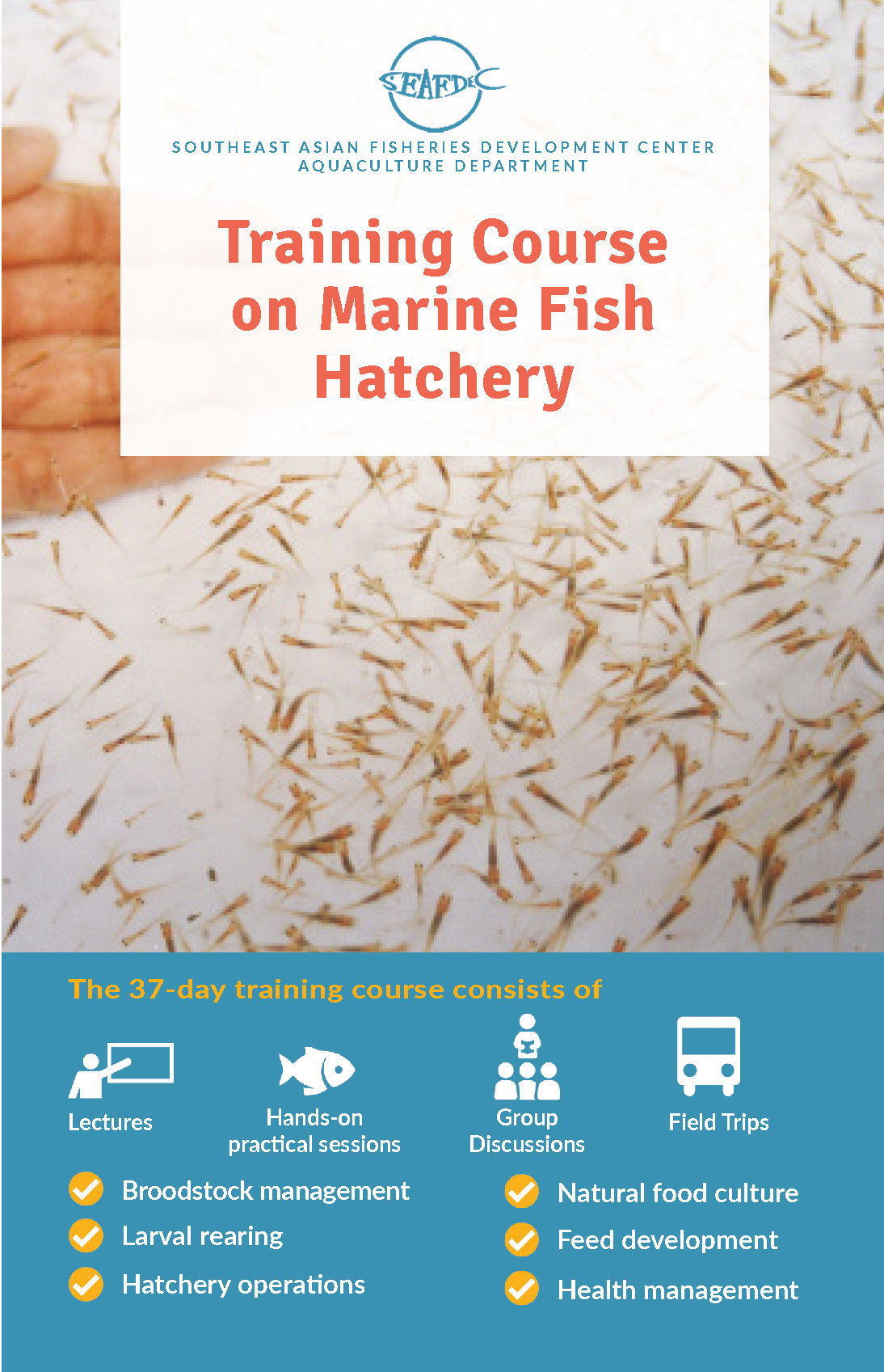 |
| View training brochure |
To apply, kindly contact:
Training and Information Division
(63-33) 330 7030
training@seafdec.org.ph
Check out our training schedule: www.seafdec.org.ph/training
 SEAFDEC/AQD Southeast Asian Fisheries Development Center | Aquaculture Department
SEAFDEC/AQD Southeast Asian Fisheries Development Center | Aquaculture Department